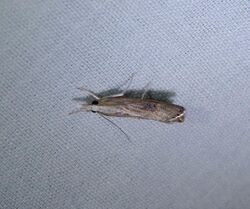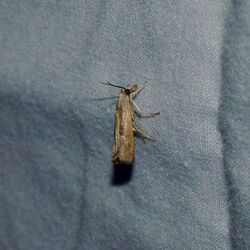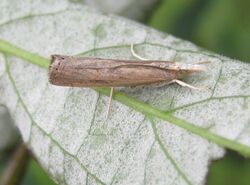Biology:Parapediasia teterrellus
| Parapediasia teterrellus | |
|---|---|

| |

| |
| Scientific classification | |
| Domain: | Eukaryota |
| Kingdom: | Animalia |
| Phylum: | Arthropoda |
| Class: | Insecta |
| Order: | Lepidoptera |
| Family: | Crambidae |
| Subfamily: | Crambinae |
| Tribe: | Crambini |
| Genus: | Parapediasia |
| Species: | P. teterrellus
|
| Binomial name | |
| Parapediasia teterrellus (Zincken, 1821)[1]
| |
| Synonyms | |
| |
Parapediasia teterrellus, the bluegrass webworm moth, bluegrass webworm, bluegrass sod webworm moth or bluegrass sod webworm, is a moth of the family Crambidae.
The wingspan is about 21 mm. Adults are on wing from May to October in two generations per year.
The larvae feed on Poa species, Festuca arundinacea and occasionally Cynodon dactylon. Full-grown larvae overwinter within a silk-lined tunnel in the soil or thatch.
Parapediasia teterrellus was first described in 1821 from Georgia, one of the first pyralid moths recorded in North America. Its geographic distribution has been affected by the human colonization of North America. By the late 1800s, Parapediasia teterrellus encompassed the midwestern United States. It was recorded in Albuquerque, NM and Tucson, AZ in 1935-1940, Los Angeles in 1954, and the San Francisco Bay area in 1988. It has effectively replaced its lawn moth competitors Tehama bonifatella and Crambus sperryellus in urban areas.[2]
Parapediasia teterrellus is currently found in North America from Ontario and New England to Florida, west to California and north to Nebraska.[3] It has also been introduced to Japan and eastern China , where it is an invasive species.[4]
References
| Wikimedia Commons has media related to Parapediasia teterrellus. |
- ↑ Nuss, M. (2003–2017). "GlobIZ search". http://globiz.pyraloidea.org/Pages/Reports/TaxonReport.aspx. Retrieved December 15, 2017.
- ↑ Powell, Jerry A.; Opler, Paul A. (2009). Moths of Western North America. University of California Press. ISBN 9780520251977.
- ↑ "Species Parapediasia teterrellus - Bluegrass Webworm Moth - Hodges#5451". BugGuide. September 18, 2017. https://bugguide.net/node/view/69913. Retrieved December 15, 2017.
- ↑ Identification and damage of the bluegrass webworm moth, Parapediasia teterrella (Zincken) (Lepidoptera: Crambidae), a new invasive pest on lawns in Shanghai, Eastern China
Wikidata ☰ Q7135628 entry
 |


